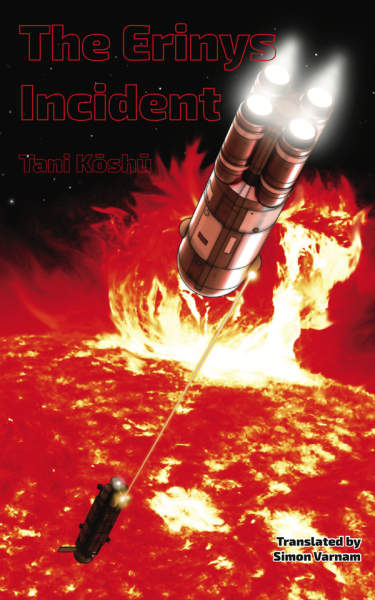We All Want To Change The World
The Erinys Incident
By Tani Kōshū

21 Jun, 2018
The 1983 novel The Erinys Incident is part of a future history series by Tani Kōshū. The 2018 Korudahan Press edition was translated by Simon Varnam.
The 2099 Outer Planet Revolt was as bold as it was unsuccessful. Tactical success failed to compensate for strategic errors. A year after it began, the Revolt was crushed by TerraLune’s AeroSpaceForce. Occupation of the rebel planetary systems followed, then status as quasi-independent states under the eye of the ASF.
A generation after the Revolt, the diehards of the Outer Planet Alliance are ready to try again.
A mysterious ship has attracted the attention of the ASF combat vessel Aquarius. Unaware they are being pursued, the phantom ship leads Aquarius down past the Sun, on a course that must lead to the outer system. It could be heading to Jupiter’s trailing Trojans, Saturn, or even distant Uranus. Or the moons of Uranus, one of which is Erinys.
The Uranian moons are all of them harsh, resource-scarce frontier worlds, Before the revolt, Erinys had planned to tap into tidal power. Those plans came to naught, but a recent deployment of fusion generators has made up the energy deficit. All seems to be going well, but …
The Outer Planets Alliance (OPA) has concocted a cunning scheme: overthrow Erinys’ civilian government and declare independence from the Uranian Federation. OPA imagines that the Erinysians will acquiesce in the takeover; most of them are recent settlers, having been deported from the Galilean moons after the Revolt. It seems unlikely that they would feel any loyalty to the Federation (or the ASF that effectively controls it). Were they to object … well, Uranus and its moons are so far out that that by the time the ASF can mount a response, the OPA will be in firm control of Erinys. After Erinys, the liberation of Jupiter’s moons can only be a matter of time!
Or so the OPA believes.
Port Erinys’ Mayor Ducrey is oblivious to the forces conspiring against him. Police Chief Lopez, on the other hand, may not look like a canny operator, but he’s canny enough to know something is up. What? He has a good guess. The police force is small; it may not be able to resist the OPA forces, but Lopez hopes to be able to substitute smarts for military might.
Unbeknownst to either Lopez or the OPA, Aquarius is on its way. If it can figure out the ultimate destination of its mysterious prey.
~oOo~
Because the book was written in 1983, many assumptions about the Uranian system have been upended. Also, because the book was written in 1983, the gender roles could come straight out of the 1980s. Because they do.
Author Tani Kōshū seems to like detailed infodumps — about the setting, as well as the people. He describes the setting at enough length that I could natter on at equal length about all the technological choices made and the reasonableness thereof. But I won’t, having some pity on my readers. I will just note that I do like books which lend themselves to such discussion, rather than relying on what is essentially chrome-plated magic. Most space operas, for example, don’t worry about waste heat management or the space version of the Siberian Curse. This novel does.
There have been a great many thinly disguised American Revolution IN SPAAACE! novels over the years, books in which stalwart colonials overthrow the oppressive central government to win their precious freedom.
The Erinys Incident is not another one of those books.
The outer colonies might believe that they’re being victimized by TerraLune. But hard technological limits make settling the Solar System out past Saturn problematic. Most industry and agriculture are based on solar power and there just isn’t much sunlight in the outer system. The communities around Neptune and Uranus depend on support from the developed worlds: Earth and the Moon. Actual independence would be followed by decline and extinction.
I believe the Pacific War (WWII in the Pacific) looms larger in the author’s mind than does the American Revolution1. Certainly, the OPA’s reliance on swift, brilliant strikes, strikes that depend on everything going just right; on the ASF never being able to bring to bear its vast industrial reserves; on a profound ability to kid themselves about just how all this would turn out — all this reminded me of the cunning plan that transformed Japan from would-be Great Power to an assortment of smoking ruins in the 1940s.
Lucky for the outer planets that TerreLune is remarkably humane, as victorious powers go. The author could have modelled his narrative on the Shimabara Rebellion.
Against a vast backdrop, various characters act out their parts, blinded by the fog of war and by deliberate misinformation as to the larger context of their actions. Coincidence, poor character judgment, misunderstandings, and simple bad luck play as great a role in the conflict as do the brilliant schemes of the OPA and its opponents. It’s all well and good to imagine the Grand Destiny of Humanity, but imagined worlds can be erased by one grieving father. There may be a lesson there.
The Erinys Incident is available here (Amazon). It does not appear to be available from Chapters-Indigo.
1: It’s possible the author has other events in mind. For example, the situation is oddly parallel with some aspects of the Upper and Lower Canada Uprisings. However, I would be amazed if the author had even heard of them, let alone had been inspired by them.
